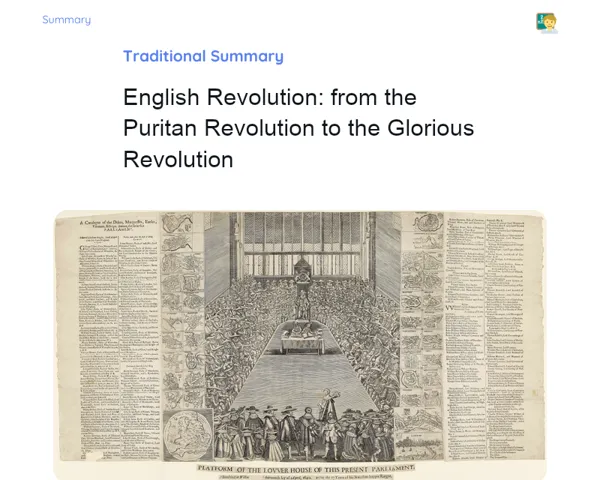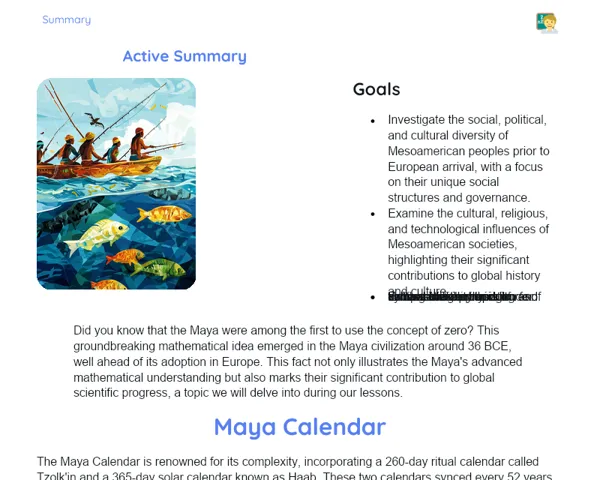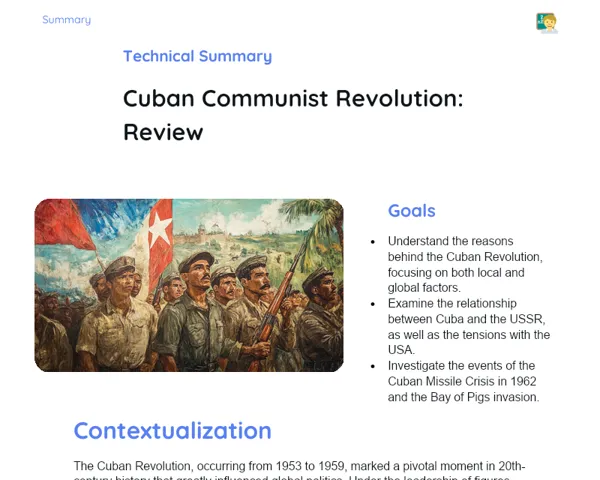Summary Tradisional | Russian Revolution
Contextualization
The Russian Revolution of 1917 stands as one of the most pivotal occurrences of the 20th century, bringing about significant political, social, and economic shifts in Russia. At the time, the country was under the absolute rule of Tsar Nicholas II, who faced escalating structural problems including vast social inequality, a largely agrarian economy, and widespread discontent among the working class. Furthermore, the late industrialisation of Russia resulted in dire working conditions, igniting further unrest amongst urban workers and peasants.\n\nWorld War I (1914-1918) only intensified these issues. The war placed enormous strain on Russia's economy, leading to severe food shortages, rampant inflation, and elevated death rates among soldiers. The Tsar’s inability to resolve these crises resulted in growing dissatisfaction among the populace, culminating in his abdication in March 1917. Amidst this turmoil, the Bolsheviks, under Vladimir Lenin’s leadership, rallied around the slogan 'Peace, Land, and Bread,' gaining substantial support and ultimately seizing power in October 1917, thus establishing a communist regime.
To Remember!
Background of the Russian Revolution
The Russian Revolution was not an overnight occurrence; it was the result of a prolonged period of social and economic dissatisfaction. Russian society was starkly divided, with a small aristocratic elite enjoying luxuries while the vast majority, made up of peasants and urban workers, grappled with extreme poverty. The late onset of industrialisation brought harsh working conditions and growing discontent among workers. Additionally, the absence of meaningful land reforms left peasants destitute, perpetuating rural hardship.\n\nPolitical oppression played a crucial role as well. The Tsarist regime resisted all reform efforts, ruthlessly suppressing protests and dissent, which fostered a climate of immense discontent and hopelessness. The pressures of World War I further aggravated these tensions, putting a heavy strain on the Russian economy and leading to food shortages, inflation, and high soldier mortality rates. The government’s failure to tackle these issues stoked the fires of dissatisfaction, setting the stage for revolution.\n\nTherefore, the combination of social inequality, political repression, and economic crises created a situation that was no longer tenable. The Russian populace was primed for radical change, as revolutionary movements began to gather momentum. The Russian Revolution can thus be seen as a culmination of a long-standing decline in living conditions and the Tsarist government's failure to enact necessary reforms in response to societal needs.
-
Extreme social inequality between the aristocracy and the general populace.
-
Political oppression and rejection of reforms by the Tsarist regime.
-
The negative impact of World War I on Russia’s social fabric and economy.
The End of the Monarchy
The downfall of the Tsarist government marked a significant turning point in Russian history. In March 1917, Tsar Nicholas II abdicated, marking the end of over 300 years of Romanov rule. The monarchy, resistant to various reform attempts, finally buckled under intense public pressure and its incompetence in dealing with the economic crisis and World War I. The government’s failure to meet the population’s basic needs resulted in an untenable situation.\n\nNicholas II’s abdication was more than a political milestone; it symbolised the collapse of the monarchical system in Russia. The monarchy, which had always portrayed itself as the people's protector, proved unable to secure even the most basic necessities for its citizens. This decline was expedited by the loss of faith from the army and political elite, who perceived the monarchy as an obstruction to national stability.\n\nAfter the abdication, a provisional government was established, attempting to enact reforms and stabilise the situation. However, this government encountered insurmountable challenges and ultimately failed to address the core issues facing Russia. Their inability to extricate Russia from World War I and resolve the economic crisis cleared the path for the Bolsheviks to take control in October 1917.
-
Abdication of Nicholas II in March 1917.
-
Failure of the Russian monarchy as a governing system.
-
Formation and eventual failure of the provisional government.
The Rise of Communism
With Nicholas II's abdication and the shortcomings of the provisional government, the conditions were ripe for the rise of the Bolsheviks, a faction led by Vladimir Lenin. The Bolsheviks, part of the Russian Social Democratic Labour Party, called for an immediate revolution in which workers would seize power. In October 1917, they orchestrated an armed uprising and took control of the government in Petrograd (now St. Petersburg), marking the onset of the October Revolution.\n\nThe Bolsheviks' promise of 'Peace, Land, and Bread' resonated widely with soldiers, peasants, and city workers alike. They vowed to pull Russia out of World War I, redistribute land to the peasants, and provide food and other essentials to urban residents. These pledges garnered significant popular support and helped to legitimise the Bolshevik takeover in the eyes of many Russians.\n\nLenin's dynamic leadership and the organisational prowess of the Bolsheviks were vital to their success. He was an astute strategist who managed to rally diverse revolutionary factions under the Bolshevik flag. Upon gaining power, the Bolsheviks set in motion radical reforms that transformed Russia’s social, economic, and political landscape, laying the foundations for the communist regime.
-
The Bolsheviks' takeover of power in October 1917.
-
The appeal of the slogan 'Peace, Land, and Bread' that drew popular support.
-
Lenin's leadership and the organisational effectiveness of the Bolsheviks.
Impact of World War I
World War I had a dire impact on Russia, magnifying existing social, economic, and political tensions. The war put tremendous pressure on the Russian economy, leading to food shortages, inflation, and a significant loss of life among soldiers. The Tsarist government's inability to manage these crises led to a further spike in public dissatisfaction, setting the stage for revolution.\n\nThe conflict also laid bare the military and administrative failures of the Tsarist regime. Frequent military losses and a shortfall in basic resources at the front severely weakened the Tsarist government. The heavy toll on Russian soldiers and the appalling conditions they faced led to widespread demoralisation among both military personnel and the civilian population.\n\nMoreover, the war served as a trigger for existing grievances. Economic hardship and rampant hunger created an atmosphere of despair and revolt. The war hastened the disintegration of the Tsarist government and paved the way for revolutionary activities, including the Bolsheviks’ pledge to extricate Russia from the war and tackle internal crises.
-
Economic and social pressures inflamed by the war.
-
The diminishing resolve of the Tsarist government due to military failures and resource shortages.
-
The war as a spark for public dissent and uprising.
Key Terms
-
Russian Revolution: A series of revolutions in 1917 that led to the collapse of the Tsarist government and the rise of communism in Russia.
-
Tsar Nicholas II: The last ruler of Russia, whose governance was plagued by crises that culminated in his abdication in 1917.
-
Social inequality: The stark contrast in living conditions between the aristocratic elite and the general populace in pre-revolutionary Russia.
-
World War I: A global conflict from 1914 to 1918 that worsened internal tensions in Russia, contributing to the revolution.
-
End of the monarchy: The abdication of Nicholas II in March 1917, which marked the end of over three centuries of Romanov rule.
-
Bolsheviks: A faction of the Russian Social Democratic Labour Party led by Vladimir Lenin, who seized power in October 1917.
-
Vladimir Lenin: The leader of the Bolsheviks, known for his charisma and strategic acumen during the Russian Revolution.
-
Communism: A political and economic ideology that advocates for the abolition of private property and aims to establish a classless society, implemented by the Bolsheviks in Russia.
-
Peace, Land, and Bread: The slogan used by the Bolsheviks to rally public support by promising to withdraw from the war, redistribute land, and ensure food supply.
Important Conclusions
The Russian Revolution of 1917 was a watershed moment in world history, leading to the downfall of the Tsarist monarchy and the ascendancy of communism. The pervasive social and economic discontent, underscored by inequality and political oppression, fostered an environment ripe for radical change. World War I, with its catastrophic consequences, acted as a catalyst for the revolution, underscoring the Tsarist government's failure to navigate internal crises.\n\nFollowing Nicholas II’s abdication, Russia entered a volatile transitional phase, during which the provisional government struggled to exert control. This power vacuum was ultimately filled by the Bolsheviks, led by Lenin, who successfully mobilised public support with their promises of 'Peace, Land, and Bread.' The October Revolution of 1917 heralded a new epoch, one characterised by the implementation of communist policies that dramatically altered the social, economic, and political framework of the nation.\n\nGrasping the significance of the Russian Revolution is essential for understanding the dynamics of political and social transformation. Its influence has resonated through revolutionary movements globally, continuing to inspire discussions around inequality, social justice, and governance. By studying this historical juncture, we gain valuable insights into the challenges and opportunities that surface during times of crisis and change.
Study Tips
-
Read widely on the Russian Revolution to deepen your understanding of the events and underlying causes.
-
Watch documentaries and films that portray the Russian Revolution for a visual and contextual grasp of the period.
-
Engage in discussions with colleagues and fellow educators to clarify questions and explore varying perspectives on the Russian Revolution.



